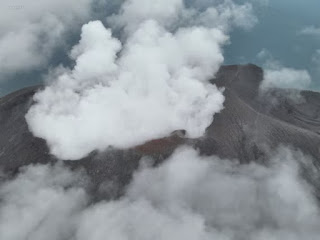Have you ever wondered how a single volcanic eruption can potentially influence Earth's climate? As Mount Ruang in Indonesia continues to erupt, spewing ash and lightning into the atmosphere, scientists are closely monitoring its impact. In this blog post, we at FreeAstroScience.com will explore the fascinating science behind volcanic ash dispersion, its potential effects on global climate, and the awe-inspiring phenomenon of volcanic lightning. Get ready to dive into the captivating world of volcanology and atmospheric science!
The Ongoing Eruption of Mount Ruang
Located in the Sangihe Islands of North Sulawesi, Indonesia, Mount Ruang has been exhibiting heightened volcanic activity since mid-April 2024. The 725-meter-tall volcano has erupted five times between April 17th and 18th, prompting the evacuation of over 11,000 residents due to concerns of a potential tsunami. The Indonesian volcanology agency has raised the alert level to the highest on the scale, expanding the exclusion zone around the crater to six kilometers.
The eruption of Mount Ruang, Indonesia, on April 19, 2024. © BASARNAS / Handout/Anadolu/ Getty Images
Volcanic Ash in the Stratosphere: A Climate Concern
During the latest eruption on the night of April 17-18, Mount Ruang propelled ash up to an astonishing 23,000 meters above sea level[1]. This has raised concerns among scientists, as the ash may have reached the stratosphere, the atmospheric layer above the troposphere where we live. When volcanic material enters the stratosphere, it can be transported over vast distances, creating a veil that blocks the sun's rays from reaching Earth's surface. This phenomenon can lead to a cooling effect on the atmosphere, as witnessed during the 1991 eruption of Mount Pinatubo in the Philippines[2].
Monitoring Volcanic Ash: The Role of Volcanic Ash Advisory Centers
To ensure aviation safety, nine Volcanic Ash Advisory Centers (VAACs) around the world continuously monitor the location and movement of volcanic ash clouds[3]. These centers provide crucial information to airlines and air traffic controllers, as volcanic ash poses a significant hazard to aircraft. The Darwin VAAC, overseen by the Australian Bureau of Meteorology, has detected two distinct layers of volcanic ash from Mount Ruang's eruption moving in different directions - one towards the west and southwest, and another towards the east at higher altitudes[1].
The Spectacle of Volcanic Lightning
One of the most captivating aspects of Mount Ruang's eruption is the intense lightning activity associated with it. Volcanic lightning occurs due to the friction between ash particles and air molecules, generating static discharges[4]. Chris Vagasky, director of the Wisconsin Environmental Mesonet, reported that nearly 4,000 lightning strikes were detected within a single hour during the Ruang eruption[1]. This phenomenon is not uncommon in large-scale volcanic eruptions, as evidenced by the Hunga Tonga-Hunga eruption in January 2022, which produced over 400,000 lightning strikes[5].
Conclusion
As Mount Ruang continues to erupt, the scientific community remains vigilant in monitoring its impact on the atmosphere and global climate. While a single eruption may not have a significant effect, repeated eruptions could lead to a cooling of the atmosphere, as seen in the past. The study of volcanic ash dispersion and its potential climatic consequences is crucial for understanding the complex interplay between volcanoes and our planet's delicate balance. At FreeAstroScience.com, we strive to bring you the latest updates and insights into these fascinating geological events, making complex scientific principles accessible to all.
Related Sources:
- More than 11,000 evacuated in northern Indonesia as volcano erupts - Al Jazeera
- Volcanic Ash and Ashfall - National Weather Service
- Human and Environmental Impacts of Volcanic Ash - National Geographic
- Volcanic Ash Advisory Centers - National Weather Service



Post a Comment